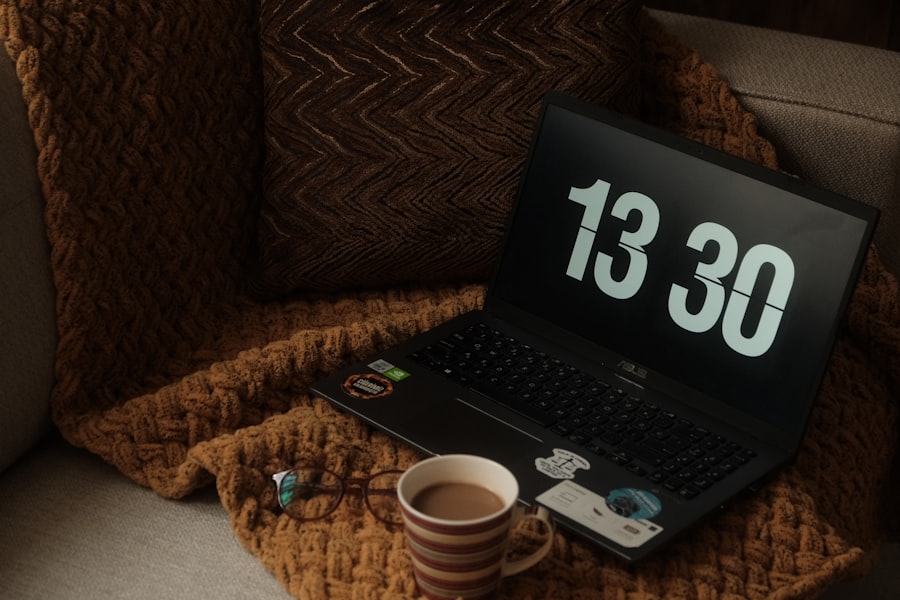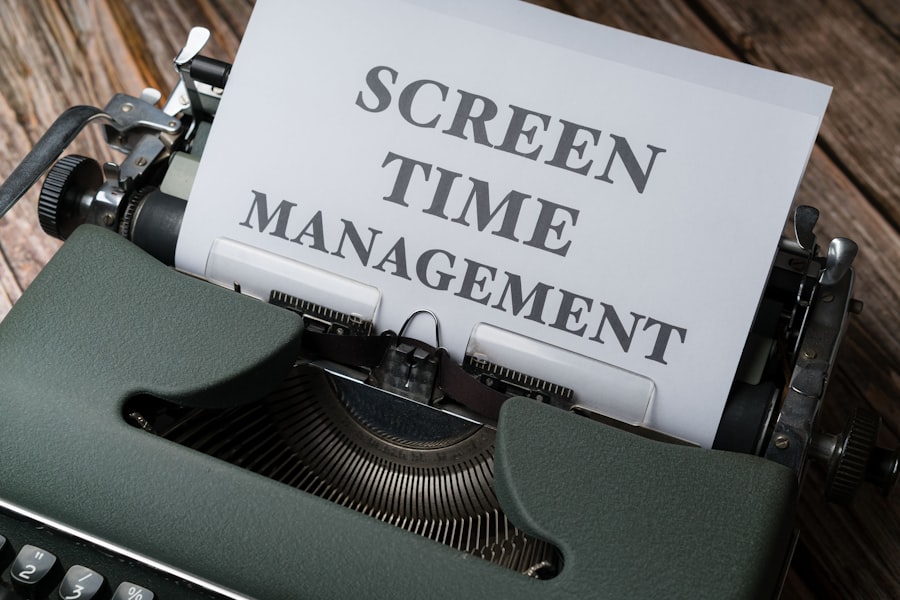In today’s digital age, screen time has become an integral part of your daily routine. Whether you are working from home, attending virtual classes, or simply scrolling through social media, the hours spent in front of a screen can accumulate quickly. You may find yourself experiencing screen time fatigue, a condition characterized by eye strain, headaches, and a general sense of exhaustion.
This fatigue arises from prolonged exposure to screens, which can lead to discomfort and decreased productivity.
You might notice that your eyes feel dry or strained after a long day of staring at your computer or smartphone.
This discomfort can be exacerbated by poor lighting conditions or improper screen positioning. Additionally, the blue light emitted by screens can disrupt your sleep patterns, making it harder for you to unwind at the end of the day. Recognizing these signs is the first step toward mitigating the effects of screen time fatigue.
By acknowledging how excessive screen use impacts your physical and mental health, you can take proactive measures to create a more balanced lifestyle.
Key Takeaways
- Excessive screen time can lead to fatigue and strain on the eyes and mind.
- Setting boundaries and limits on screen time can help prevent fatigue and burnout.
- Taking regular breaks from screens, such as the 20-20-20 rule, can reduce eye strain and fatigue.
- Engaging in physical activity can help counteract the sedentary effects of prolonged screen time.
- Adjusting screen settings and using blue light filters can reduce eye strain and fatigue.
Setting Boundaries and Limits
Establishing boundaries around your screen time is essential for maintaining a healthy relationship with technology. You may find it helpful to set specific times during the day when you will engage with screens and times when you will disconnect. For instance, you could designate certain hours for work-related tasks while reserving evenings for relaxation and family time.
By creating these boundaries, you can prevent screens from encroaching on your personal life and ensure that you have dedicated moments to recharge. In addition to setting time limits, consider implementing rules for specific activities. For example, you might decide to limit social media usage to 30 minutes per day or restrict recreational screen time to weekends only.
These limits can help you regain control over your time and reduce the overwhelming feeling that often accompanies excessive screen use. By consciously deciding when and how long you will engage with screens, you empower yourself to prioritize other aspects of your life that contribute to your overall well-being.
Taking Regular Breaks

Incorporating regular breaks into your screen time routine is vital for combating fatigue and maintaining focus. You may find that taking short breaks every hour can significantly improve your productivity and reduce eye strain. During these breaks, step away from your screen and engage in activities that allow your eyes and mind to rest.
This could involve stretching, walking around your home, or simply closing your eyes for a few moments to relax. Moreover, consider using techniques like the Pomodoro Technique, which encourages you to work in focused bursts followed by short breaks. This method not only helps you stay on task but also ensures that you are giving yourself the necessary downtime to recharge.
Engaging in Physical Activity
| Age Group | Percentage Engaging in Physical Activity |
|---|---|
| Children (6-17 years) | 65% |
| Adults (18-64 years) | 53% |
| Older Adults (65+ years) | 32% |
Physical activity plays a crucial role in counteracting the effects of screen time fatigue. When you spend long hours in front of a screen, your body can become stiff and fatigued. Engaging in regular exercise helps to alleviate this tension and boosts your energy levels.
You might consider incorporating activities such as walking, jogging, or yoga into your daily routine. These exercises not only promote physical health but also improve mental clarity and focus. Additionally, try to integrate movement into your day-to-day activities.
For instance, if you have a sedentary job, make it a point to stand up and stretch every hour or take brief walks during breaks. You could also opt for standing desks or ergonomic chairs that encourage better posture while working. By prioritizing physical activity, you create a healthier balance between screen time and movement, ultimately enhancing your overall well-being.
Practicing the 20-20-20 Rule
One effective strategy for reducing eye strain associated with prolonged screen use is the 20-20-20 rule. This simple guideline suggests that for every 20 minutes spent looking at a screen, you should take a 20-second break to look at something 20 feet away. This practice allows your eyes to refocus and reduces the risk of digital eye strain.
You may find it helpful to set reminders on your phone or computer to ensure that you adhere to this rule throughout the day. Implementing the 20-20-20 rule not only benefits your eyes but also encourages you to take regular breaks from your work or leisure activities. During these brief pauses, take a moment to stretch or breathe deeply, allowing yourself to reset both physically and mentally.
By incorporating this simple yet effective technique into your daily routine, you can significantly reduce the discomfort associated with extended screen time.
Adjusting Screen Settings

Adjusting your screen settings can make a significant difference in how comfortable you feel during prolonged use. You may want to experiment with brightness levels, contrast settings, and text size to find what works best for you. A well-lit environment can help reduce glare on your screen, making it easier for your eyes to focus without straining.
Additionally, consider using dark mode settings on applications and devices where available. Dark mode can be easier on the eyes, especially in low-light conditions, as it reduces the amount of blue light emitted by screens. By taking the time to customize your screen settings according to your preferences, you can create a more comfortable viewing experience that minimizes fatigue.
Using Blue Light Filters
Blue light filters are another effective tool for reducing the impact of screen time on your eyes and overall health. Many devices now come equipped with built-in blue light filtering options that can be activated in settings. If your device does not have this feature, consider investing in blue light blocking glasses that can be worn while using screens.
By reducing exposure to blue light, especially in the evening hours, you may find it easier to fall asleep at night. This is particularly important if you often use screens before bedtime, as blue light can interfere with melatonin production and disrupt your sleep cycle. Incorporating blue light filters into your daily routine can help protect your eyes while promoting better sleep hygiene.
Practicing Mindfulness and Meditation
Incorporating mindfulness practices into your daily routine can significantly enhance your ability to manage screen time fatigue. Mindfulness encourages you to be present in the moment and cultivate awareness of your thoughts and feelings without judgment. You might find it beneficial to set aside a few minutes each day for mindfulness meditation or deep breathing exercises.
These practices not only help reduce stress but also improve focus and concentration when returning to screen-related tasks. By taking time to center yourself through mindfulness techniques, you create a mental buffer against the overwhelming nature of constant digital engagement. This intentional approach allows you to navigate technology with greater ease and clarity.
Creating a Relaxing Environment
Your physical environment plays a significant role in how you experience screen time fatigue. Creating a relaxing workspace can help mitigate stress and enhance productivity. Consider decluttering your workspace and incorporating elements that promote calmness, such as plants or soothing colors.
Additionally, pay attention to lighting conditions in your environment. Natural light is ideal for reducing eye strain, so try to position your workspace near windows whenever possible. If natural light is limited, opt for soft lighting options that minimize glare on screens.
By curating a relaxing environment tailored to your needs, you can create a more enjoyable experience while using screens.
Seeking Professional Help
If you find that screen time fatigue is significantly impacting your daily life despite implementing various strategies, it may be time to seek professional help. An eye care specialist can assess any underlying vision issues that may be contributing to discomfort during screen use. They may recommend specific exercises or treatments tailored to your needs.
Additionally, if you are experiencing heightened anxiety or stress related to technology use, consider speaking with a mental health professional. They can provide guidance on managing technology-related stressors and help you develop coping strategies that promote overall well-being. Seeking professional support is an important step toward reclaiming control over your relationship with screens.
Finding Alternative Activities
Finally, finding alternative activities that do not involve screens is essential for achieving balance in your life. You might explore hobbies such as reading physical books, gardening, or engaging in creative pursuits like painting or crafting. These activities not only provide a break from screens but also stimulate different areas of your brain.
Consider scheduling regular “screen-free” days or evenings where you engage in activities that promote connection with others or allow for personal reflection. Whether it’s playing board games with family or going for a nature walk with friends, these experiences enrich your life beyond the digital realm. By diversifying how you spend your time, you can cultivate a healthier relationship with technology while enhancing overall well-being.
In conclusion, managing screen time fatigue requires a multifaceted approach that encompasses understanding its effects, setting boundaries, taking breaks, engaging in physical activity, practicing mindfulness, and seeking professional help when necessary. By implementing these strategies into your daily routine, you can create a healthier balance between technology use and personal well-being while enjoying all the benefits that modern technology has to offer.
In today’s digital age, constant screen time has become an unavoidable part of our daily lives, leading to a phenomenon known as screen time fatigue. This condition is characterized by symptoms such as eye strain, headaches, and mental exhaustion, which can significantly impact one’s overall well-being. An insightful article on this topic can be found on Unplugged Psych, where they delve into the psychological effects of prolonged screen exposure and offer practical tips for managing screen time effectively. For more information, you can read the full article by visiting Unplugged Psych.
WATCH THIS! Your Brain Is Not Bored; AI Is Stealing Your Dopamine (76-Minute Documentary)
FAQs
What is constant screen time fatigue?
Constant screen time fatigue refers to the feeling of tiredness, eye strain, and mental exhaustion that can result from prolonged use of digital devices such as computers, smartphones, and tablets.
What are the symptoms of constant screen time fatigue?
Symptoms of constant screen time fatigue can include eye strain, headaches, dry eyes, blurred vision, neck and shoulder pain, and difficulty concentrating.
What causes constant screen time fatigue?
Constant screen time fatigue is caused by prolonged exposure to the blue light emitted by digital screens, as well as the strain on the eyes and brain from focusing on a screen for extended periods of time.
How can constant screen time fatigue be prevented?
Constant screen time fatigue can be prevented by taking regular breaks from screen time, adjusting the brightness and contrast of screens, using blue light filters, and practicing good posture and ergonomics when using digital devices.
What are the long-term effects of constant screen time fatigue?
Long-term effects of constant screen time fatigue can include worsening of vision, increased risk of developing myopia, and potential long-term damage to the eyes and brain from prolonged exposure to blue light.




